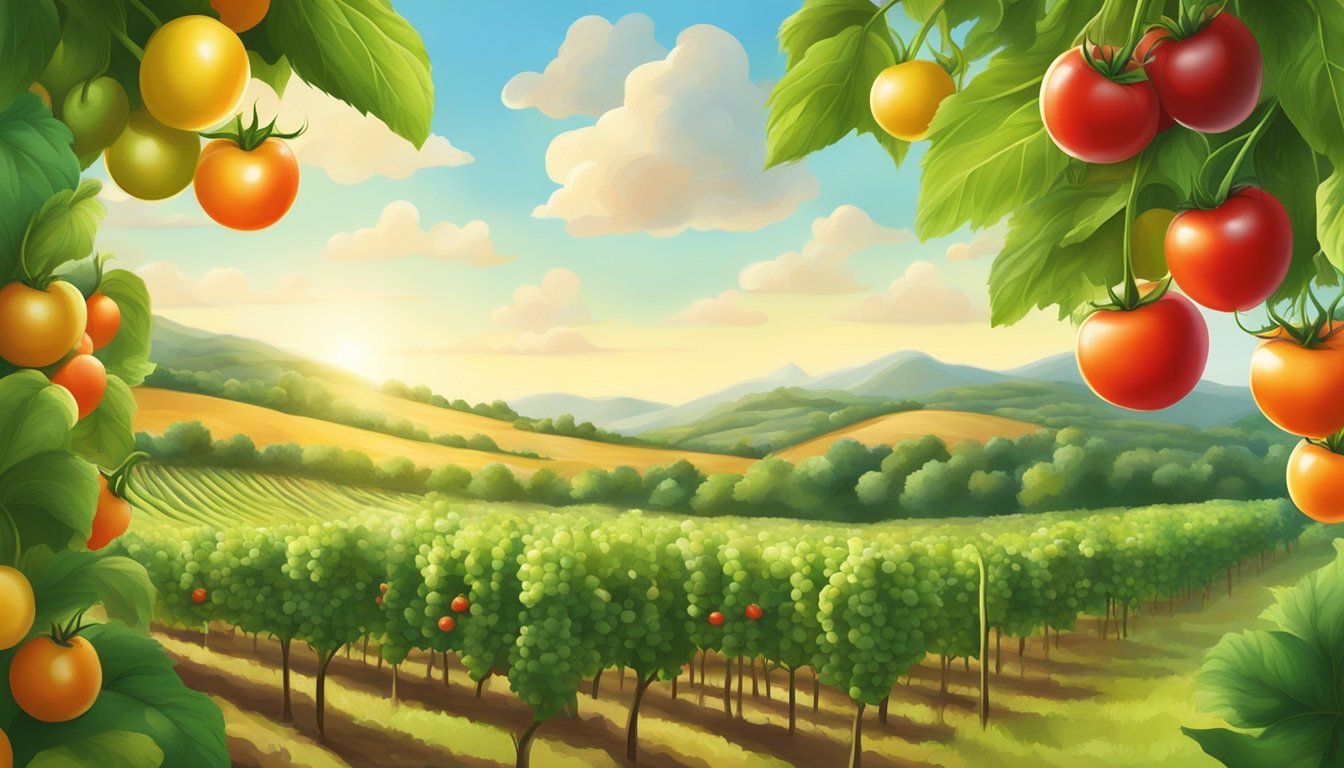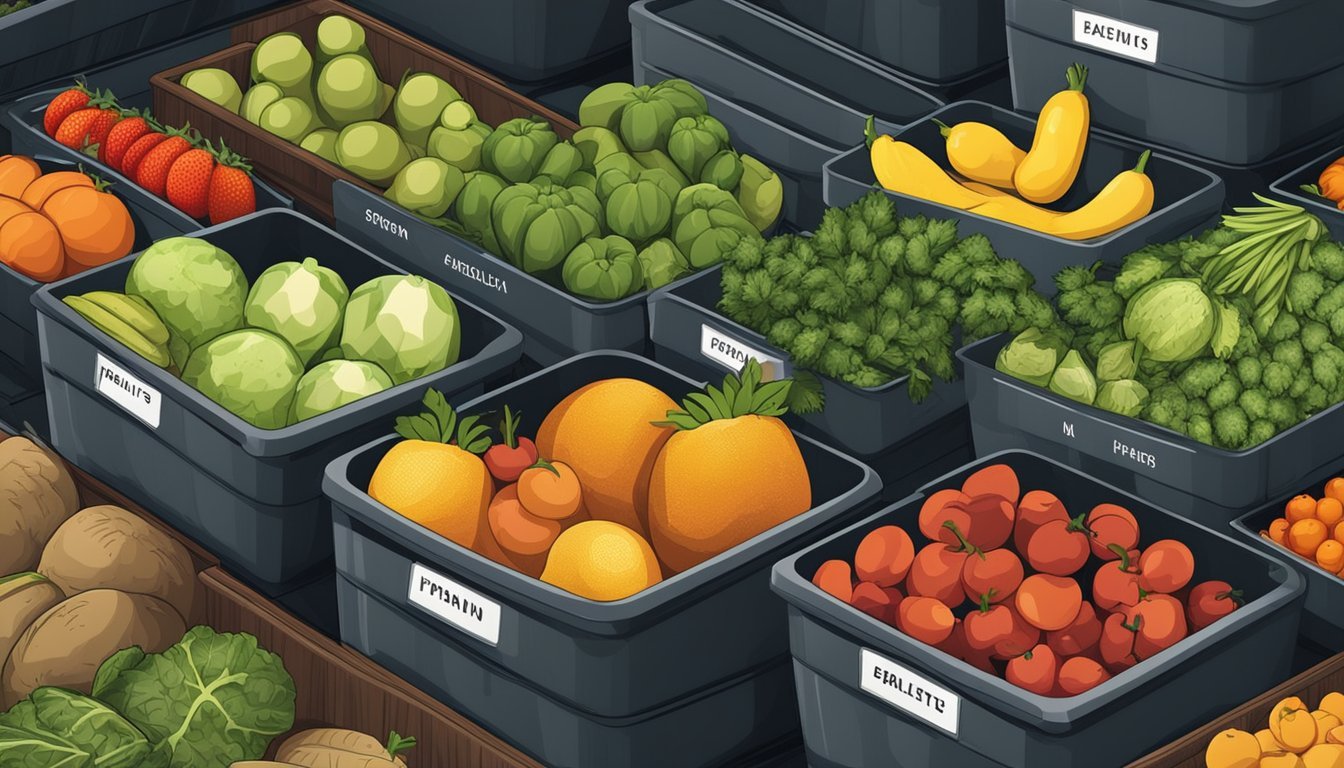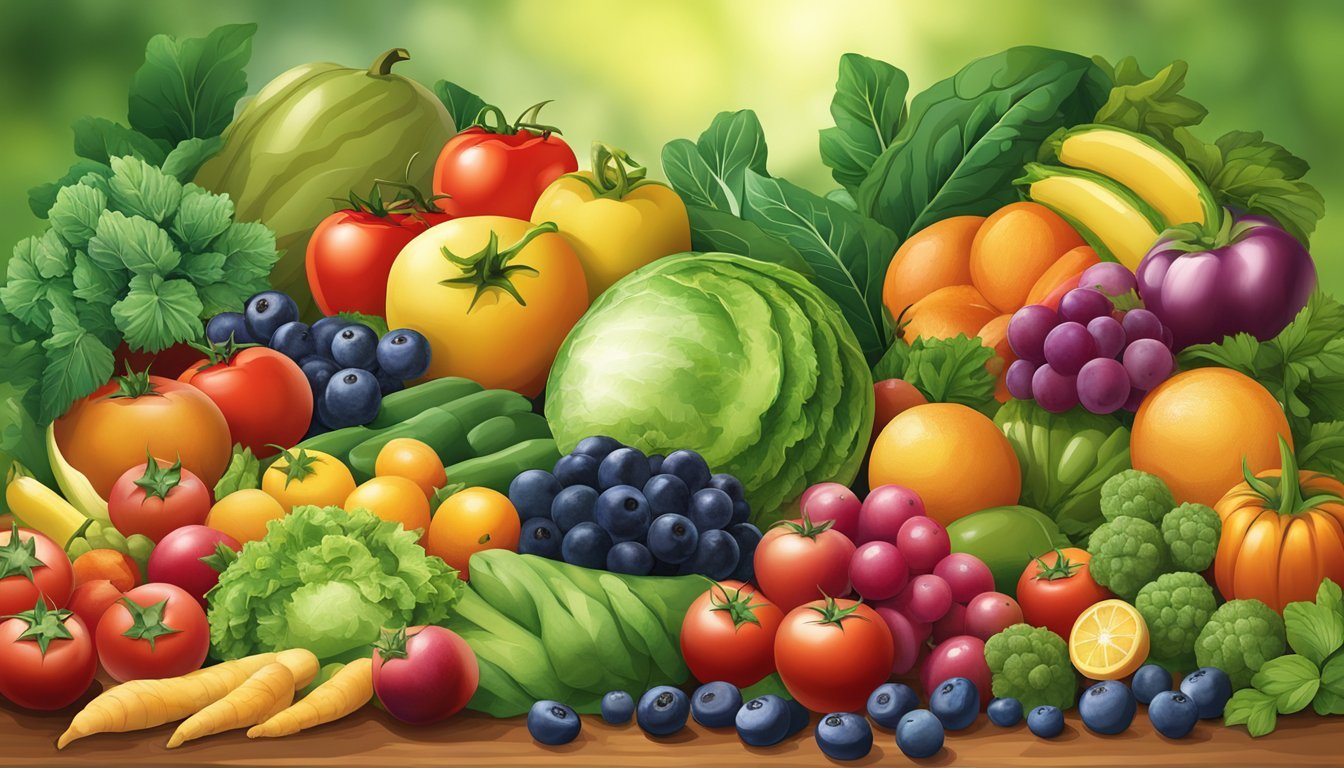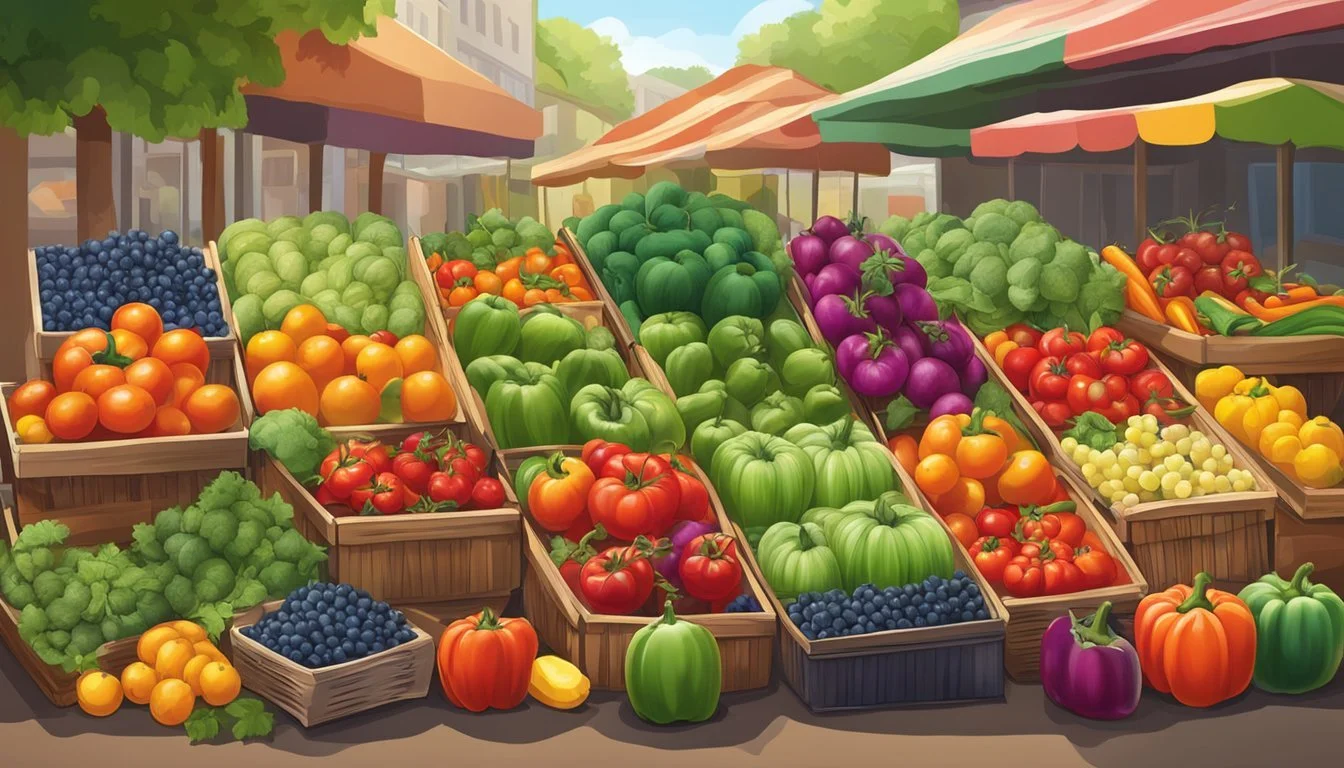Seasonal Fruit and Vegetables July
Your Guide to Fresh Produce
This Article is Part of Our Guide to Seasonal & Local Produce in the USA
July marks the heart of the summer season, a time when a wide variety of fruits (What wine goes well with fruit?) and vegetables reach their peak of freshness and flavor. During this month, farmers' markets and grocery stores are abundant with vibrant produce, offering an array of colors and tastes that are specific to this time of the year. Seasonal eating not only provides the opportunity to enjoy produce at its best but also supports local agriculture and minimizes the environmental impact of transporting goods over long distances.
The summer's warmth encourages the growth of many fruits such as berries, peaches, plums, and melons, which are just a few of the sweet choices available. Vegetables like tomatoes, cucumbers, and bell peppers (What wine goes well with bell peppers?) also thrive in the July heat, becoming ripe and ready for harvest. This seasonal bounty is not only perfect for fresh, light meals but also for grilling and outdoor dining, with flavors that are enhanced when they're fresh and in season.
Incorporating these seasonal offerings into one's diet allows for a rotation of fresh and nutritious options. Nutritional content is highest shortly after harvest, making locally sourced summer produce a healthy choice. Besides nutritional benefits, using seasonal ingredients in cooking can inspire new recipes and revitalize one's meal plan with a focus on simplicity and natural flavors inherent in fresh July produce.
What’s in Season in July in Your State?
Texas Seasonal Fruit and Veg in July
Choosing and Buying Seasonal Fruits and Vegetables
In July, the abundance of seasonal fruits and vegetables offers peak flavors and nutrition. This section provides guidance on making the most of this month's fresh produce.
Importance of Selecting In-Season Produce
Selecting in-season produce ensures that individuals are getting fruits and vegetables at their most flavorful and nutritious state. In the United States, July yields an array of fruits like ripe peaches, which are known for their bright color and juicy flavor, and vegetables that are plump and firm, reflecting their freshness. Consuming produce in its prime not only supports a healthier diet but also contributes to a better environment by reducing the carbon footprint associated with long-distance food transport.
Seasonal Fruits in July:
Peaches
Watermelon
Raspberries
Tomatoes (technically a fruit)
Seasonal Vegetables in July:
Cucumbers
Green Beans
Zucchini (What wine goes well with zucchini?)
Bell Peppers
Where to Buy Fresh Produce
Fresh produce in July can be best found at farmers' markets or local produce stands. These venues often provide a direct link to the growers, ensuring that the produce is at its freshest. Additionally, exploring the seasonal dept at the grocery store can yield a bounty of in-season selections, with many supermarkets highlighting the state or region the produce was sourced from, which can help shoppers support local agriculture.
Tips for Selecting the Best Produce
When shopping for fruits and vegetables in July, incorporate these tips to choose the highest quality, ripe, and delicious options:
Look for Bright Colors: Vivid, unblemished skin often indicates freshness and ripeness, especially in fruits like peaches.
Check Firmness: Gently press the surface of the fruit or vegetable. It should be firm but not hard, with a slight give that suggests ripeness.
Smell the Produce: A ripe peach, for instance, should have a sweet and fragrant aroma.
Store Properly: To maintain freshness, store fruits and vegetables in the appropriate climate—some may require refrigeration, while others are best kept at room temperature.
Ask Vendors: Don't hesitate to speak with the farmers or vendors for advice on selecting the best produce and ideas on how to incorporate it into meals.
Creating a shopping list before visiting the farmers' market or produce dept can help consumers stay focused on the seasonal fruits and vegetables they want to explore, while also allowing room for discovering new varieties that are in season.
Seasonal Fruits of July
In July, the array of fresh fruits is at its peak, offering a bounty that is both ripe and nutrient-rich. The season's warmth brings to life an abundance of stone fruits and berries, various melons and tropical treats, as well as a selection of citrus and other fruits. Each group delivers a unique blend of flavors and nutrients, including powerful antioxidants.
Stone Fruits and Berries
Stone fruits—so named for the hard pit or "stone" inside—arrive in abundance this month. These fruits are often at their juiciest and most flavorful:
Peaches: Fuzzy-skinned and juicy, they are a source of vitamins A and C.
Nectarines: Smooth-skinned relatives of peaches, offering a slightly firmer texture.
Plums: Diverse in size and color, plums have a sweet and slightly tart taste.
Cherries (how long do cherries last?): Deep red and delightfully sweet, they are packed with antioxidants.
Apricots: Small but mighty, with a sweet-tart flavor and beta-carotene.
Berries in July are at their prime, providing intense flavors and high antioxidant content:
Strawberries: Bright red and sweet, they are rich in vitamin C.
Blackberries: (how long do blackberries last?) Known for their deep flavor and dark color, indicative of high antioxidant levels.
Blueberries: Small, round, and bursting with subtle sweetness, they are often called a "superfood."
Raspberries: Known for their delicate structure and a balance of sweetness with a hint of tart.
Melons and Tropical Fruits
Melons are synonymous with summer, offering refreshing hydration and sweet tastes:
Watermelon: This quintessential summer fruit provides hydration and vitamins A and C.
Cantaloupe: With its soft orange flesh, it's high in beta-carotene and vitamin C.
Tropical fruits gain popularity with their bold flavors and nutrient-rich profiles:
Mango: Juicy and vibrantly flavored, mangoes deliver vitamins A and C.
Figs: Unique in texture, they contribute fiber, calcium, and iron to the diet.
Citrus and Other Fruits
Citrus fruits, although often associated with colder months, continue to provide tangy freshness:
Lemons: Tart and highly versatile, they are excellent sources of vitamin C.
Limes: Similar to lemons, with a unique zesty flavor perfect for adding a kick to dishes.
Other fruits also remain in season, offering variety and nutritional benefits:
Bananas: A staple fruit that offers potassium and quick energy.
Seasonal Vegetables of July
July is a month when a variety of fresh vegetables reach their peak of ripeness, offering a burst of flavor and essential vitamins. This is when home gardeners and local farms harvest a bounty of produce ideal for summer meals.
Leafy Greens and Salads
Leafy greens such as kale and lettuce flourish in the early part of July. These greens are rich in vitamins and perfect for cool, crisp salads. Kale is particularly hardy and can be used in everything from fresh salads to savory cooked dishes.
Kale: High in vitamins A, K, and C
Lettuce: Includes varieties like romaine, iceberg, and butterhead
Summer Squashes and Gourds
Zucchini and summer squash are staples of July vegetable gardens. These vegetables are incredibly versatile, suitable for grilling, sautéing, or even raw in salads.
Zucchini: Packed with vitamin C and often used in both sweet and savory dishes
Summer Squash: Often yellow, with a mild flavor that works well in a variety of recipes
Roots and Bulbs
Root vegetables like beets, radishes, and carrots are also ready for harvest in July. These roots are flavorful and packed with nutrients. They can be eaten raw, roasted, or used to add a crunchy texture to dishes.
Beets: Earthy flavor and rich in folate
Radishes: Peppery taste and crisp texture
Carrots: Sweet and loaded with beta-carotene
Seasonal Recipe Ideas for July
July brings a plethora of vibrant fruits and vegetables to the table, providing an excellent opportunity for cooks to explore fresh and flavorful dishes. Whether it's grilling succulent main courses or mixing up refreshing beverages, the summer harvest caters to all palates.
Salad and Side Dish Creations
Salads: A classic Peach and Tomato Salad combines juicy peaches and ripe tomatoes, dressed with a light vinaigrette. One may also toss together a vibrant Green Bean and Roasted Pepper Salad.
Side Dishes: Grilled Corn on the Cob with herbed butter or a zesty Squash and Corn Sauté with fresh herbs serve as flavorful complements to any meal.
Main Courses and Grills
Main Courses: Seared Eggplant Steaks topped with homemade tomato sauce can be a hearty vegetarian option.
Grilling: For meat lovers, Marinated Chicken with Peach Compote offers a sweet and savory profile, while Grilled Peppers and Mushrooms satisfy as a side or vegetarian main course.
Desserts and Sweet Treats
Desserts: Roasting nectarines or peaches intensifies their sweetness, perfect for a simple Roasted Peach Dessert.
Sweet Treats: A Berry Compote can be drizzled over ice cream or incorporated into summer-inspired desserts. Homemade Jams featuring July's berries provide a touch of sweetness throughout the year.
Beverage and Preservation Recipes
Beverages: A Peach and Basil Cocktail refreshes on warm evenings, while a Berry Lemonade quenches any thirst.
Preservation: For extending the shelf life of produce, Pickled Green Beans or Corn Relish make excellent choices. Crafting Homemade Tomato Sauce captures the essence of ripe tomatoes for later use.
Proper Storage of Seasonal Produce
Storing seasonal produce properly can extend its freshness and flavor. Specific techniques for fruits and vegetables help maintain quality and reduce spoilage.
Storage Techniques for Fruits
Temperature and Humidity: Most fruits fare best in the refrigerator, ideally at temperatures between 30-40°F and high humidity. Apples, for instance, can last up to several weeks when stored correctly in the fridge.
Citrus Fruits: Keep them in a mesh bag or loose in the fridge's crisper drawer.
Berries: Store in a single layer in a container, preferably with a lid, in the fridge.
Stone Fruits (peaches, plums, cherries): Place on the counter until ripe, then refrigerate.
Storage Solutions for Vegetables
Ventilation: Vegetables need air circulation to prevent mold. Using breathable bags or containers with vents can be advantageous.
Leafy Greens: Keep them in the fridge, wrapped in paper towels to absorb excess moisture.
Root Vegetables: For vegetables like potatoes and onions, a cool, dark, and dry place like a pantry works well, but they should not be refrigerated.
Containers: Storage in airtight containers can protect vegetables from moisture and keep them fresh.
Longevity and Preservation Tips
Freezing: Freezing is an excellent option for extending the shelf life of produce beyond the standard 5 days. Vegetables should be blanched before freezing, while fruits can be frozen directly.
Herbs: They can be frozen in oil within ice cube trays or dried for preservation.
Pickling: Vegetables such as cucumbers can be turned into pickles for a longer shelf life.
Fruits: If fruits start to brown, one can make preserves or jams.
Storage Check: Regularly check stored produce for any signs of spoilage and remove affected items to protect the rest.
Health Benefits and Nutritional Information
Eating fruits and vegetables during their peak season in July ensures the highest quality of freshness, flavor, and nutritional content. They often contain an abundance of essential vitamins, antioxidants, and nutrients that are crucial for maintaining good health.
Vitamins and Antioxidants in Fruits
Fruits that ripen in July, like cherries and berries, are typically rich in vitamin C and antioxidants. Vitamin C is vital for the repair and growth of all body tissues, while antioxidants help in preventing cell damage. Stone fruits, such as peaches and nectarines, also offer a significant amount of vitamins and have compounds that can protect against various health conditions.
Cherries: High in vitamin C; offer melatonin, which regulates sleep cycles.
Berries: Raspberries and blueberries are packed with antioxidants like quercetin and anthocyanin.
Nutrients and Fiber in Vegetables
Vegetables thriving in the heat of July, including bell peppers, eggplants, and zucchini, are filled with a variety of nutrients. These vegetables provide dietary fiber which is beneficial for digestive health. They also have a good range of both vitamins and minerals.
Bell Peppers: Excellent source of vitamins A and C; rich in beta-carotene.
Eggplants: Contains fiber and is high in antioxidants, particularly nasunin in the skin, which is known for its potential to protect brain cells.
Zucchini: A good source of B vitamins, particularly folate and B6, as well as magnesium and potassium.
Consuming an assortment of fruits and vegetables from the July seasonal selection supports a well-rounded diet with a denser nutrient profile.
Exploring Local and Regional Varieties
When discussing local and regional produce, it's essential to note that each area has distinct offerings during the summer months, particularly in July. These varieties cater to the climatic and soil conditions of the region, providing consumers with a unique taste of the season.
Fruit Varieties by Region
Northeast United States:
Berries: July is prime time for berry picking, with blackberries and blueberries offering a sweet and antioxidant-rich treat for locals.
Stone Fruits: Plums begin to hit their peak, presenting a juicy option for fresh eating or for preparing summer desserts.
Southeast United States:
Melons: Regions in the southeast often boast a selection of ripe cantaloupes, known for their hydrating and sweet qualities in the summer heat.
Midwest United States:
Cherries: Midwestern states may see a variety of cherries come into season, with tart varieties being popular for pies and sweet varieties enjoyed fresh.
Vegetable Varieties by Region
Southwest United States:
Tomatoes: Ideal growing conditions for tomatoes are found in southwestern states, where they ripen into a flavorful addition to salads and salsas.
Peppers: Another product of the warm summers is a range of peppers from sweet bell varieties to hotter options, perfect for regional dishes.
Pacific Northwest United States:
Leafy Greens: Cooler areas of the Pacific Northwest continue to produce leafy greens like spinach and kale, which thrive in the mild summer climate.
Legumes: Fresh beans and peas hit their stride, offering a crisp, fresh element to meals.
Utilizing these local and regional varieties in cooking not only provides a fresher flavor profile but also supports local economies and sustainable agriculture practices.






